Simulation of Fracture Performance of Die-Cast A356 Aluminum Alloy Based on Modified Mohr–Coulomb Model
Abstract
:1. Introduction
2. Materials and Experiment Procedure
3. Material Failure Theory Model
4. Numerical Model
5. Results and Discussion
6. Conclusions
Author Contributions
Funding
Institutional Review Board Statement
Informed Consent Statement
Data Availability Statement
Conflicts of Interest
References
- Talebi-Ghadikolaee, H.; Moslemi Naeini, H.; Mirnia, M.J.; Mirzai, M.A.; Alexandrov, S.; Gorji, H. Experimental and numerical investigation of failure during bending of AA6061 aluminum alloy sheet using the modified Mohr-Coulomb fracture criterion. Int. J. Adv. Manuf. Technol. 2019, 105, 5217–5237. [Google Scholar] [CrossRef]
- Li, J.; Chen, L.; Jiang, S.; Gan, H.; Hao, W. Numerical Simulation and Process Optimization of Magnesium Alloy Vehicle Dashboard Cross Car Beam (CCB) Based on MAGMA. Processes 2023, 11, 16. [Google Scholar] [CrossRef]
- Parlak, İ.E.; Emel, E. Deep learning-based detection of aluminum casting defects and their types. Eng. Appl. Artif. Intell. 2023, 118, 105636. [Google Scholar] [CrossRef]
- Qin, D.; Chen, C.; Ouyang, Y.; Wu, J.; Zhang, H. Finite element methods used in clinching process. Int. J. Adv. Manuf. Technol. 2021, 116, 2737–2776. [Google Scholar] [CrossRef]
- Chi, H.; Yan, M.; Xu, Z.; Xiang, P.; An, Z.; Huang, H. Analysis on the Quenching Deformation Characteristics of Light Cast Aluminum Alloy Wheels and Their Control Strategies. Metals 2023, 13, 128. [Google Scholar] [CrossRef]
- Kong, D.; Sun, D.; Yang, B.; Qiao, H.; Wei, C.; Lang, Y.; Song, H.; Gao, J. Characterization and modeling of damage behavior of a casting aluminum wheel considering inhomogeneity of microstructure and microdefects. Eng. Fail. Anal. 2023, 145, 107018. [Google Scholar] [CrossRef]
- Zhang, Y.; Shen, F.; Zheng, J.; Münstermann, S.; Li, T.; Han, W.; Huang, S. Ductility prediction of HPDC aluminum alloy using a probabilistic ductile fracture model. Theor. Appl. Fract. Mech. 2022, 119, 103381. [Google Scholar] [CrossRef]
- Seupel, A.; Hütter, G.; Kuna, M. On the identification and uniqueness of constitutive parameters for a non-local GTN-model. Eng. Fract. Mech. 2020, 229, 106817. [Google Scholar] [CrossRef]
- Bao, Y.; Wierzbicki, T. On fracture locus in the equivalent strain and stress triaxiality space. Int. J. Mech. Sci. 2004, 46, 81–98. [Google Scholar] [CrossRef]
- Rice, J.R.; Tracey, D.M. On the ductile enlargement of voids in triaxial stress fields. J. Mech. Phys. Solids 1969, 17, 201–217. [Google Scholar] [CrossRef]
- McClintock, F.A. A Criterion for Ductile Fracture by the Growth of Holes. J. Appl. Mech. 1968, 35, 363–371. [Google Scholar] [CrossRef]
- Reddi, D.; Areej, V.K.; Keralavarma, S.M. Ductile failure simulations using a multi-surface coupled damage-plasticity model. Int. J. Plast. 2019, 118, 190–214. [Google Scholar] [CrossRef]
- Villaseñor Rodríguez, I. Publicaciones españolas para la fundamentación de un marco teórico sobre los estudios de usuarios de información. Investig. Bibl. 2014, 28, 223–257. [Google Scholar] [CrossRef]
- Nahshon, K.; Xue, Z. A modified Gurson model and its application to punch-out experiments. Eng. Fract. Mech. 2009, 76, 997–1009. [Google Scholar] [CrossRef]
- Nielsen, K.L.; Tvergaard, V. Ductile shear failure or plug failure of spot welds modelled by modified Gurson model. Eng. Fract. Mech. 2010, 77, 1031–1047. [Google Scholar] [CrossRef]
- He, Z.; Zhu, H.; Hu, Y. An improved shear modified GTN model for ductile fracture of aluminium alloys under different stress states and its parameters identification. Int. J. Mech. Sci. 2021, 192, 106081. [Google Scholar] [CrossRef]
- Khan, A.S.; Liu, H. A new approach for ductile fracture prediction on Al 2024-T351 alloy. Int. J. Plast. 2012, 35, 1–12. [Google Scholar] [CrossRef]
- Bai, Y.; Wierzbicki, T. A new model of metal plasticity and fracture with pressure and Lode dependence. Int. J. Plast. 2008, 24, 1071–1096. [Google Scholar] [CrossRef]
- Mu, L.; Jia, Z.; Ma, Z.; Shen, F.; Sun, Y.; Zang, Y. A theoretical prediction framework for the construction of a fracture forming limit curve accounting for fracture pattern transition. Int. J. Plast. 2020, 129, 102706. [Google Scholar] [CrossRef]
- Mohr, D.; Marcadet, S.J. Micromechanically-motivated phenomenological Hosford–Coulomb model for predicting ductile fracture initiation at low stress triaxialities. Int. J. Solids Struct. 2015, 67–68, 40–55. [Google Scholar] [CrossRef]
- Lou, Y.; Huh, H.; Lim, S.; Pack, K. New ductile fracture criterion for prediction of fracture forming limit diagrams of sheet metals. Int. J. Solids Struct. 2012, 49, 3605–3615. [Google Scholar] [CrossRef]
- Barsoum, I.; Faleskog, J. Rupture mechanisms in combined tension and shear—Experiments. Int. J. Solids Struct. 2007, 44, 1768–1786. [Google Scholar] [CrossRef]
- Bai, Y.; Wierzbicki, T. Application of extended Mohr–Coulomb criterion to ductile fracture. Int. J. Fract. 2010, 161, 1–20. [Google Scholar] [CrossRef]
- Cheng, C.; Meng, X.; Wu, Y.; Shi, L.; Wu, H.; Cao, T.; Zhang, S.; Zhao, J. On Dynamic Mechanical Properties of 3003 Aluminum Alloy Based on Generalized Incremental Stress-State-Dependent Damage Model with Modified Johnson–Cook Equation. J. Mater. Eng. Perform. 2023, 32, 451–461. [Google Scholar] [CrossRef]
- GB/T 228.1-2010; Metallic materials—Tensile testing—Part 1: Method of test at room temperature. Standardization Administration of the People’s Republic of China: Beijing, China, 2010.
- GB/T 30069.2-2016; Metallic materials—Tensile testing at high strain rates—Part 2: Servo-hydraulic and other test systems. Standardization Administration of the People’s Republic of China: Beijing, China, 2016.
- Xiao, Y.; Hu, Y. Numerical and Experimental Fracture Study for 7003 Aluminum Alloy at Different Triaxialities. Met. Mater.-Int. 2021, 27, 2499–2511. [Google Scholar] [CrossRef]
- Otroshi, M.; Rossel, M.; Meschut, G. Stress state dependent damage modeling of self-pierce riveting process simulation using GISSMO damage model. J. Adv. Join. Process. 2020, 1, 100015. [Google Scholar] [CrossRef]
- Moussa, M.E.; El-Hadad, S.; Khalifa, W. Influence of chemical modification by Y2O3 on eutectic Si characteristics and tensile properties of A356 alloy. Trans. Nonferrous Met. Soc. China 2019, 29, 1365–1374. [Google Scholar] [CrossRef]
- Sajjadi, S.A.; Ezatpour, H.R.; Parizi, M.T. Comparison of microstructure and mechanical properties of A356 aluminum alloy/Al2O3 composites fabricated by stir and compo-casting processes. Mater. Des. 2012, 34, 106–111. [Google Scholar] [CrossRef]
- Torre, A.; Pérez-Bustamante, R.; Camarillo-Cisneros, J.; Gómez-Esparza, C.D.; Medrano-Prieto, H.M.; Martínez-Sánchez, R. Mechanical properties of the A356 aluminum alloy modified with La/Ce. J. Rare Earths 2013, 31, 6. [Google Scholar] [CrossRef]
- Shi, Z.; Wang, Q.; Shi, Y.; Zhao, G.; Zhang, R. Microstructure and mechanical properties of Gd-modified A356 aluminum alloys. J. Rare Earths 2015, 33, 1004–1009. [Google Scholar] [CrossRef]
- Kimura, T.; Nakamoto, T. Microstructures and mechanical properties of A356 (AlSi7Mg0.3) aluminum alloy fabricated by selective laser melting. Mater. Des. 2016, 89, 1294–1301. [Google Scholar] [CrossRef]
- Smerd, R.; Winkler, S.; Salisbury, C.; Worswick, M.; Lloyd, D.; Finn, M. High strain rate tensile testing of automotive aluminum alloy sheet. Int. J. Impact Eng. 2005, 32, 541–560. [Google Scholar] [CrossRef]
- Du, Z.; Cui, X.; Yang, H.; Xia, W. Deformation and fracture behavior of 5052 aluminum alloy by electromagnetic-driven stamping. Int. J. Adv. Manuf. Technol. 2022, 123, 3955–3968. [Google Scholar] [CrossRef]
- Sun, L.; Cai, Z.; Gao, J.; Wang, M.; Li, L. Calibration of Ductile Fracture Criterion with Optimal Experiment Design and Prediction on Forming Limit for Aluminum Alloy Sheet. Met. Mater.-Int. 2022, 28, 848–861. [Google Scholar] [CrossRef]
- Zhang, Z.; Cui, Y.; Chen, Q. Damage and failure characterization of 7075 aluminum alloy hot stamping. J. Mech. Sci. Technol. 2022, 36, 351–357. [Google Scholar] [CrossRef]
- Effelsberg, J.; Haufe, A.; Feucht, M.; Neukamm, F.; Dubois, P. On Parameter Identification for the GISSMO Damage Model. In Proceedings of the 11th LS-DYNA Forum, Uim, Germany, 9–10 October 2012. [Google Scholar]
- Jiang, W.M.; Fan, Z.T.; Liu, D.J. Microstructure, tensile properties and fractography of A356 alloy under as-cast and T6 obtained with expendable pattern shell casting process. Trans. Nonferrous Met. Soc. China 2012, 22, s7–s13. [Google Scholar] [CrossRef]
- Chan, K.S.; Jones, P.; Wang, Q. Fatigue crack growth and fracture paths in sand cast B319 and A356 aluminum alloys. Mater. Sci. Eng. A 2003, 341, 18–34. [Google Scholar] [CrossRef]
- Ma, Z.Y.; Mishra, R.S.; Mahoney, M.W. Superplasticity in cast A356 induced via friction stir processing. Scr. Mater. 2004, 50, 931–935. [Google Scholar] [CrossRef]
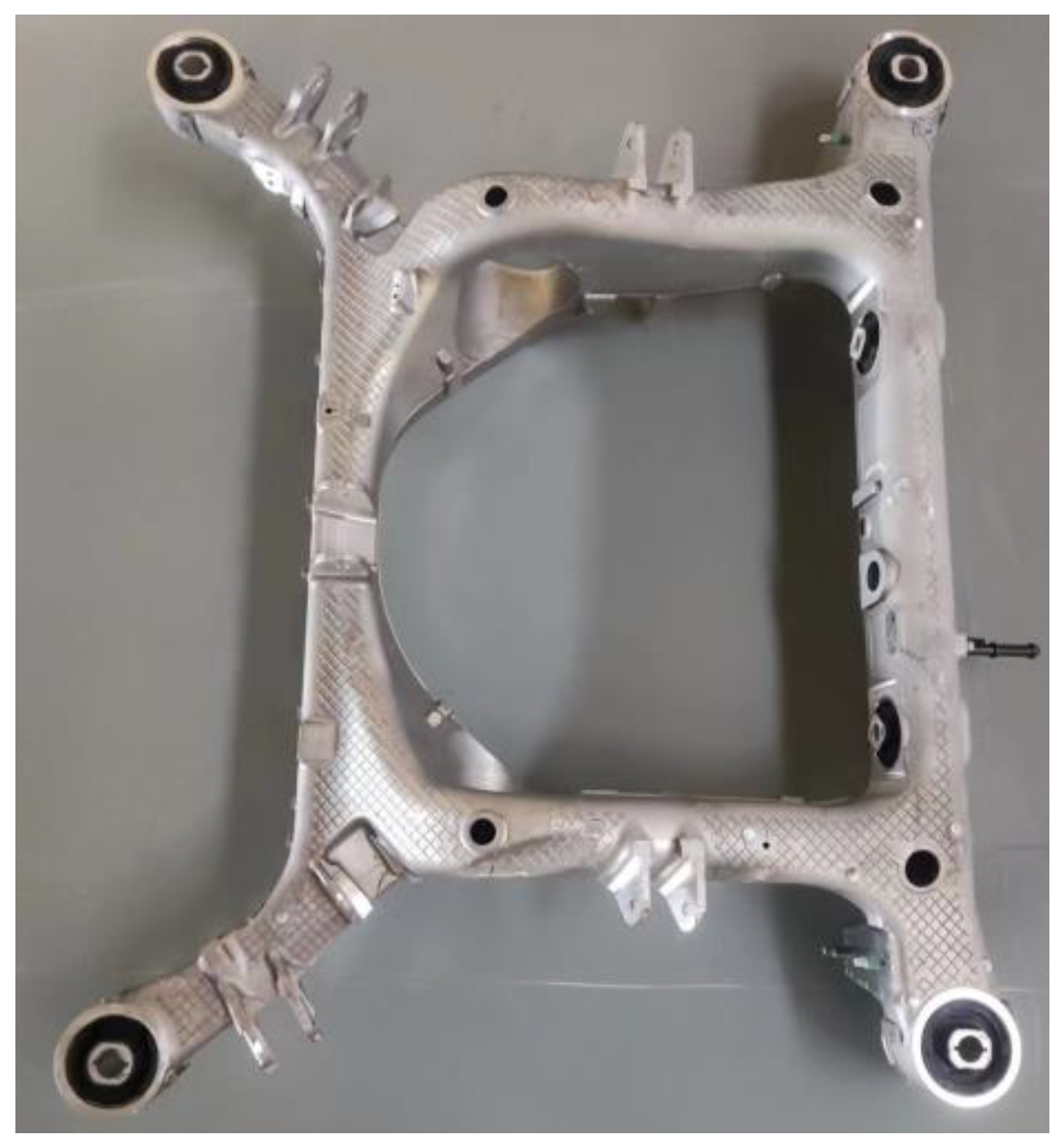
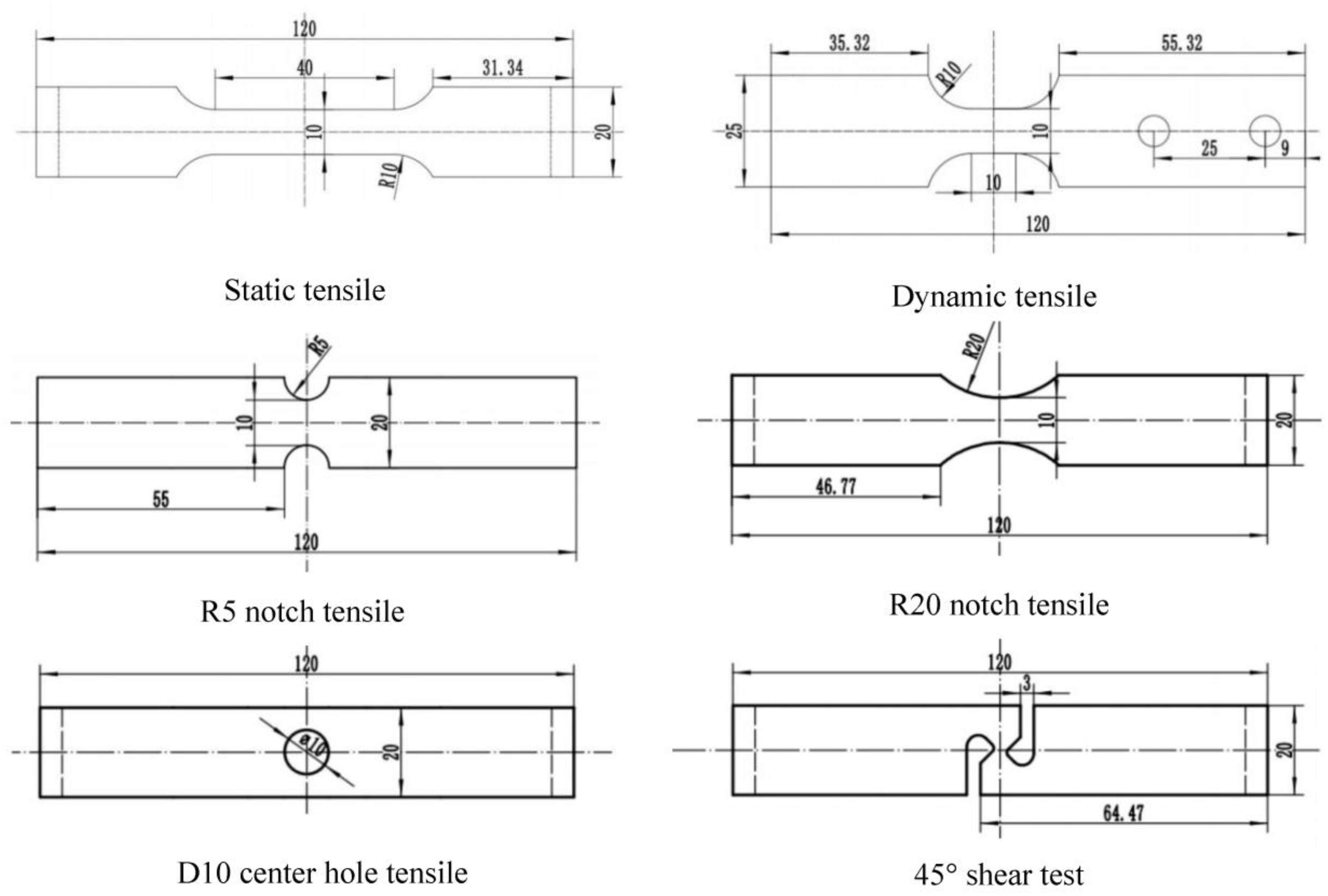
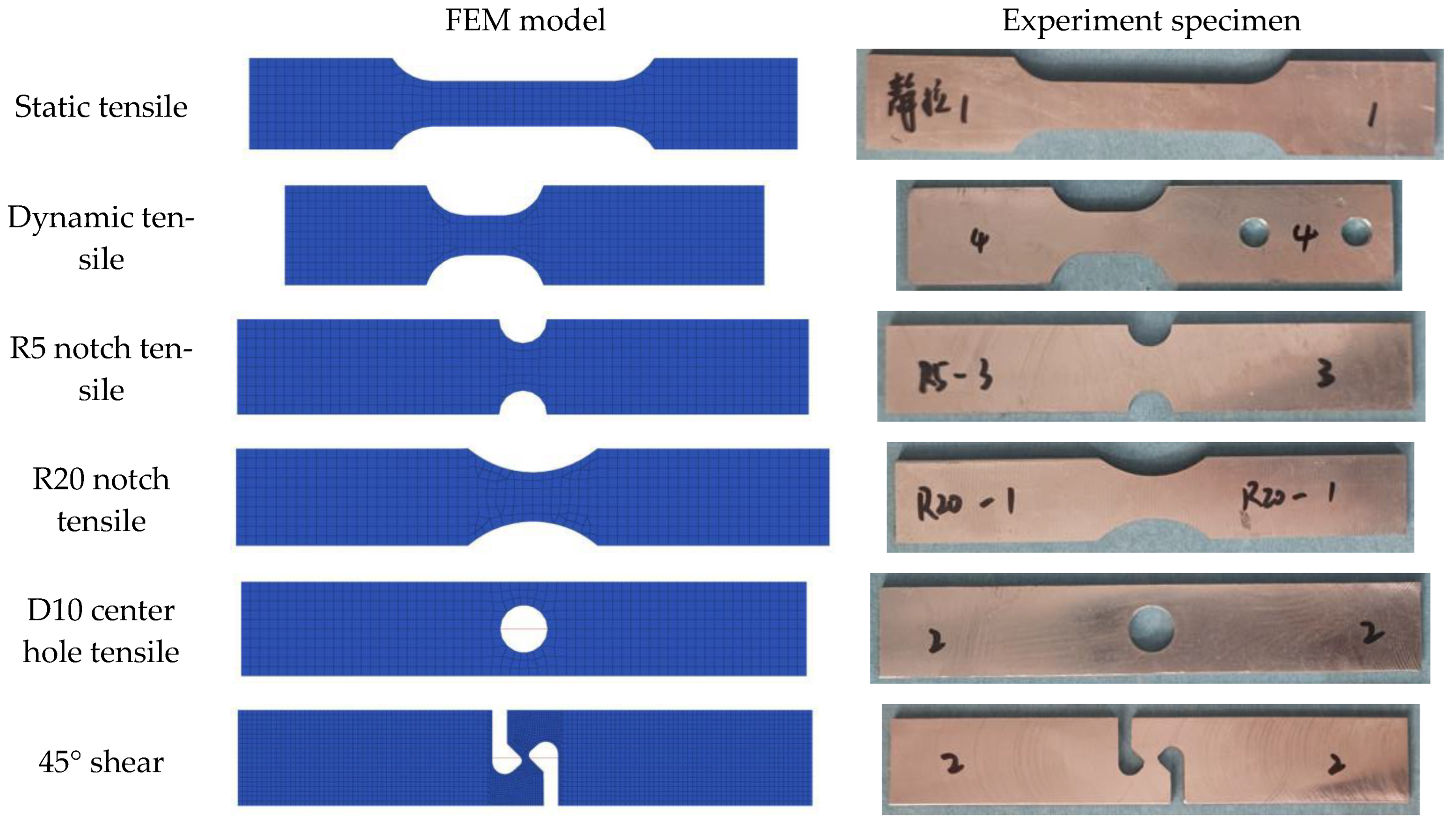
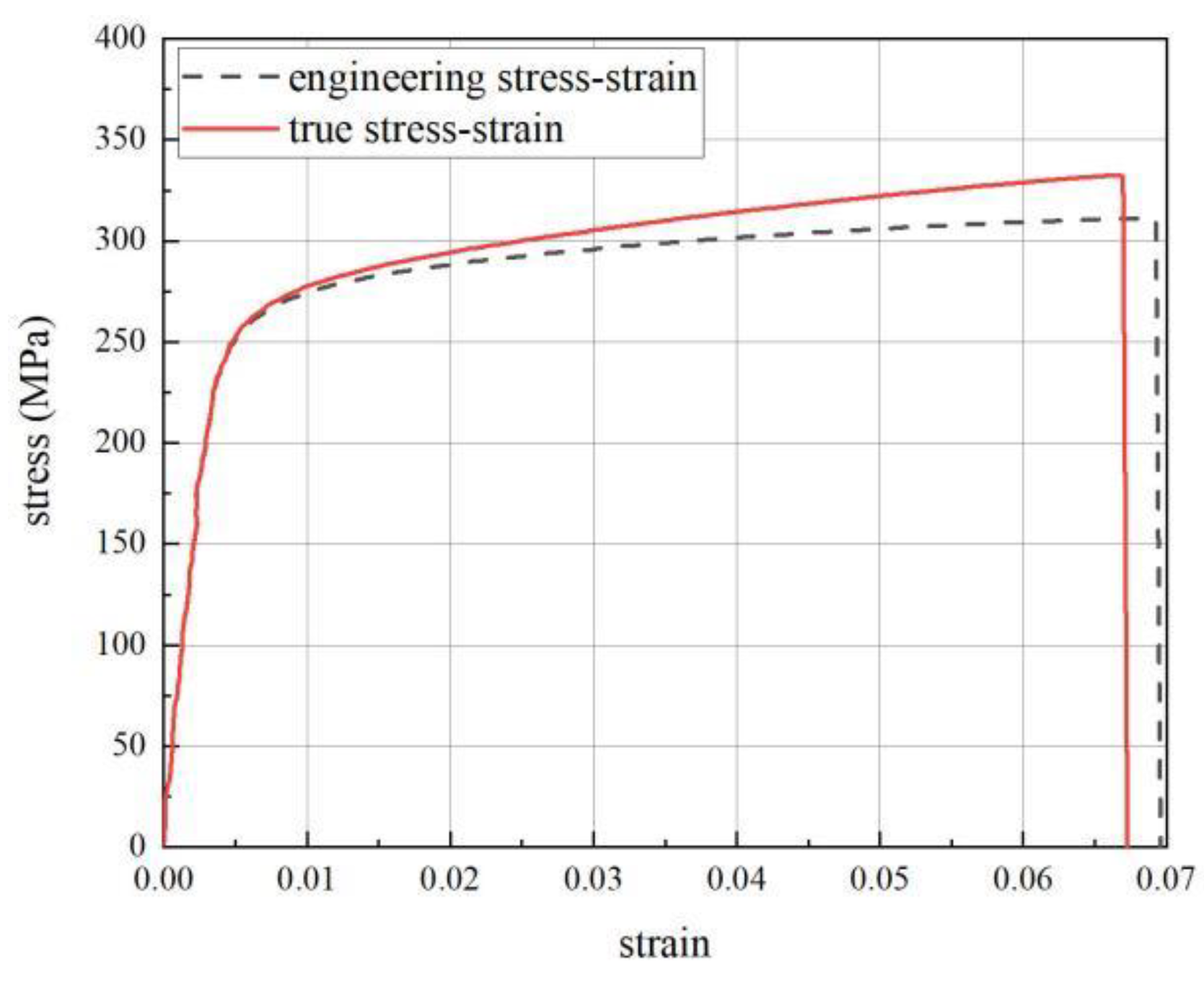
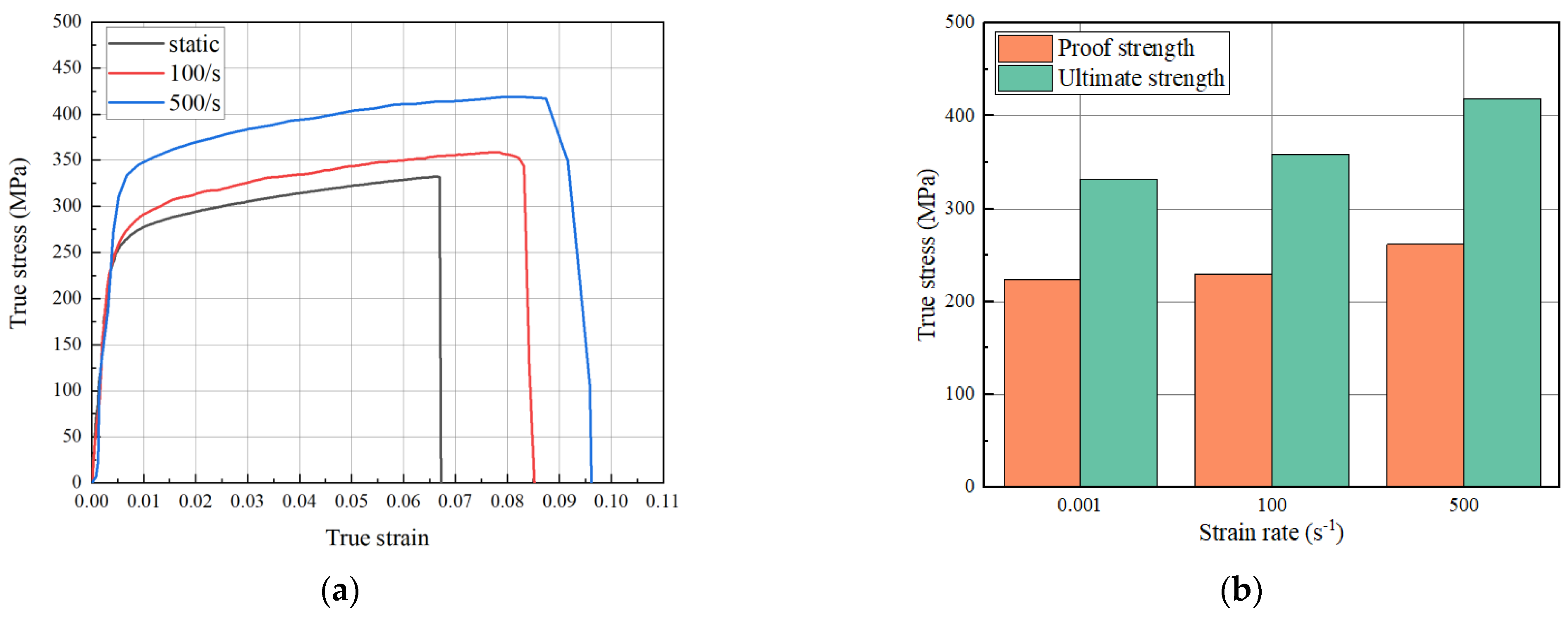
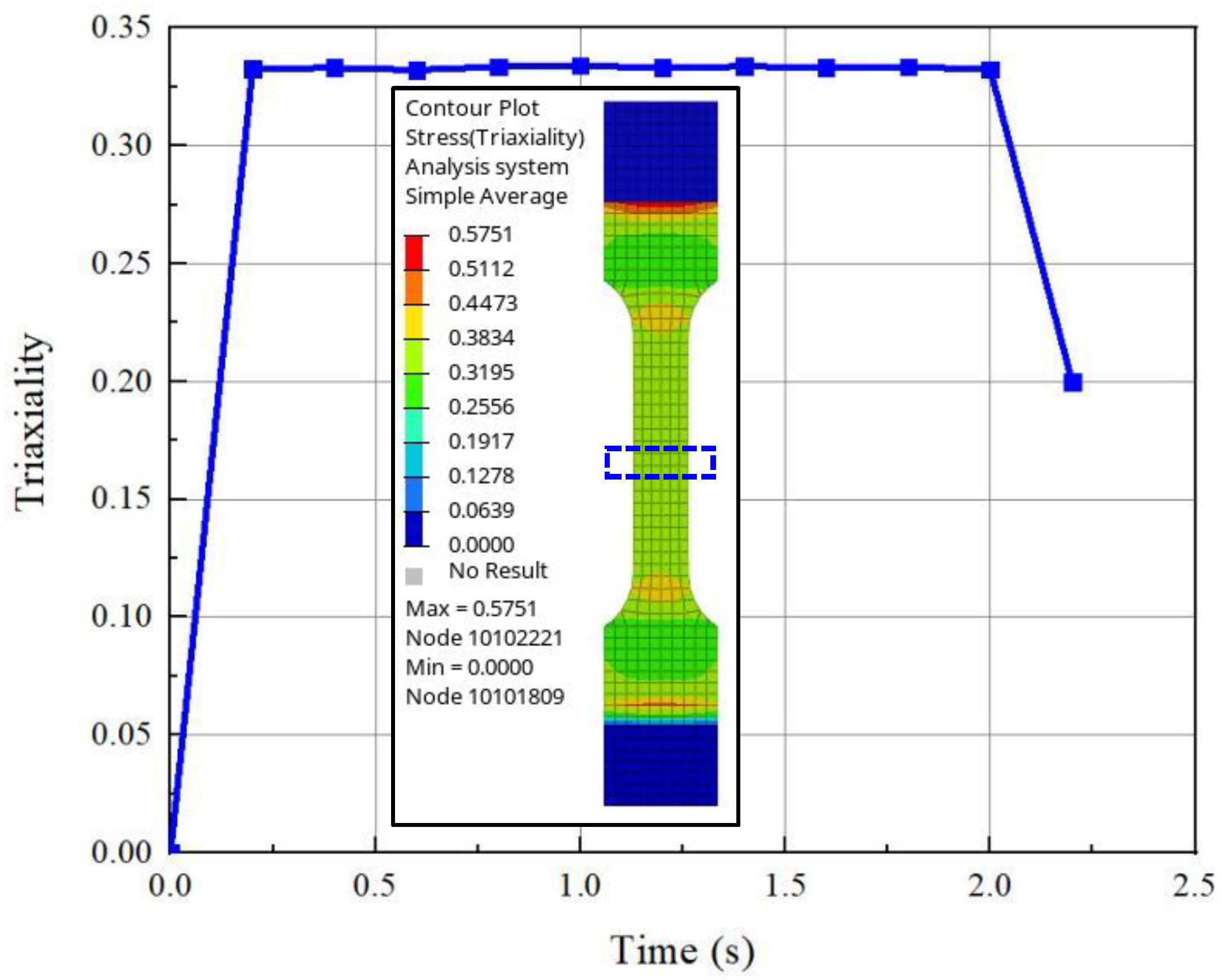



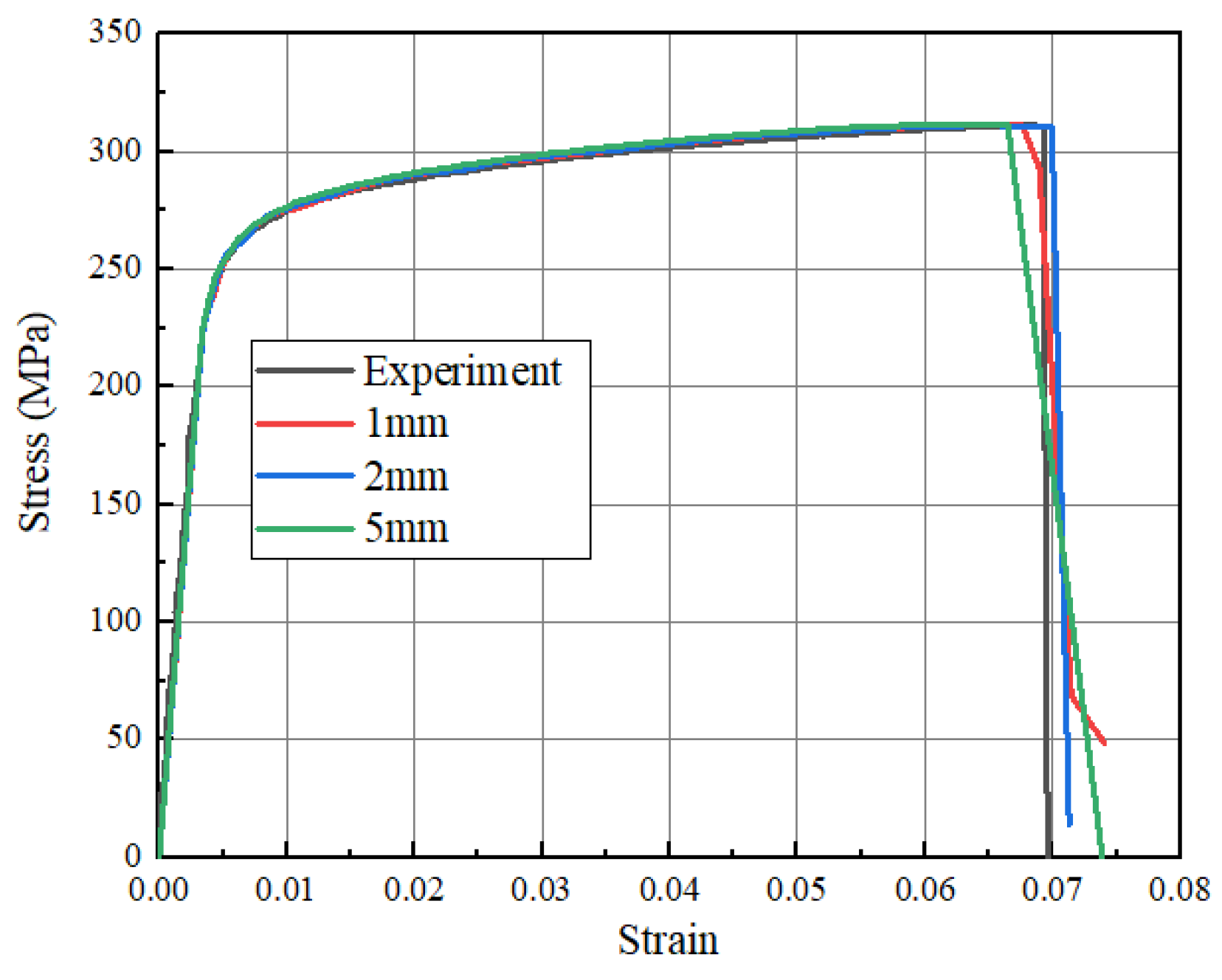

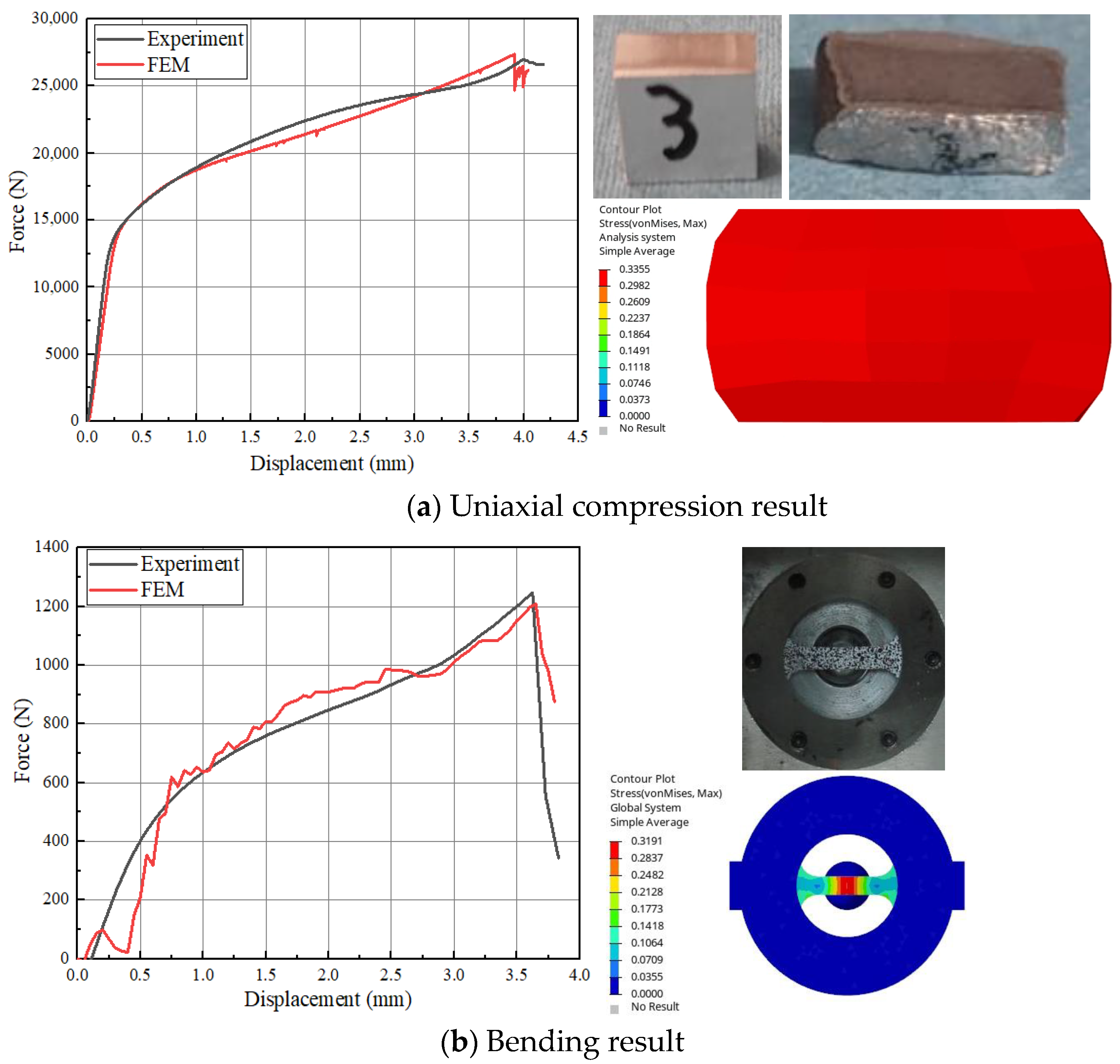
| Si | Fe | Mn | Zn | Mg | Cu | Ti |
|---|---|---|---|---|---|---|
| 7 | 0.6 | 0.35 | 0.35 | 0.3 | 0.25 | 0.25 |
| Material | Test | Reference Standard [25,26] | Repeat Time | Strain Rate |
|---|---|---|---|---|
| A356 | Static tensile | GB/T 228.1-2010 | 3 | 0.001/s |
| Dynamic tensile | GB/T 30069.2-2016 | 3 | 100/s, 500/s | |
| R5 notch | GB/T 228.1-2010 | 3 | 0.001/s | |
| R20 notch | GB/T 228.1-2010 | 3 | 0.001/s | |
| D10 center hole | GB/T 228.1-2010 | 3 | 0.001/s | |
| 45° shear | GB/T 228.1-2010 | 3 | 0.001/s |
| Specimen | Stress Triaxiality | Equivalent Plastic Strain at Fracture |
|---|---|---|
| Uniaxial tensile | 0.33 | 0.065 |
| R5 notch | 0.5 | 0.081 |
| R20 notch | 0.42 | 0.12 |
| D10 center hole | 0.37 | 0.067 |
| 45°shear | 0.25 | 0.13 |
| Experiment | Displacement at Fracture (mm) | Ultimate Force (N) | ||||
|---|---|---|---|---|---|---|
| Experiment | FEM | Error | Experiment | FEM | Error | |
| Static tensile | 2.76 | 2.8 | 1.5% | 15,545 | 15,645 | 0.64% |
| R5 notch | 0.55 | 0.546 | 0.72% | 18,083 | 18,201 | 0.65% |
| R20 notch | 0.755 | 0.756 | 0.13% | 16,673 | 16,554 | 0.71% |
| D10 center hole | 0.536 | 0.511 | 4.6% | 16,317 | 16,349 | 0.196% |
| 45° shear | 0.923 | 0.946 | 2.49% | 1768.36 | 1770.72 | 0.13% |
Disclaimer/Publisher’s Note: The statements, opinions and data contained in all publications are solely those of the individual author(s) and contributor(s) and not of MDPI and/or the editor(s). MDPI and/or the editor(s) disclaim responsibility for any injury to people or property resulting from any ideas, methods, instructions or products referred to in the content. |
© 2023 by the authors. Licensee MDPI, Basel, Switzerland. This article is an open access article distributed under the terms and conditions of the Creative Commons Attribution (CC BY) license (https://creativecommons.org/licenses/by/4.0/).
Share and Cite
Zhang, S.; Wu, X.; Yang, M.; Ren, P.; Meng, X. Simulation of Fracture Performance of Die-Cast A356 Aluminum Alloy Based on Modified Mohr–Coulomb Model. Appl. Sci. 2023, 13, 6456. https://doi.org/10.3390/app13116456
Zhang S, Wu X, Yang M, Ren P, Meng X. Simulation of Fracture Performance of Die-Cast A356 Aluminum Alloy Based on Modified Mohr–Coulomb Model. Applied Sciences. 2023; 13(11):6456. https://doi.org/10.3390/app13116456
Chicago/Turabian StyleZhang, Sai, Xiaozhong Wu, Mingyuan Yang, Pengfei Ren, and Xianming Meng. 2023. "Simulation of Fracture Performance of Die-Cast A356 Aluminum Alloy Based on Modified Mohr–Coulomb Model" Applied Sciences 13, no. 11: 6456. https://doi.org/10.3390/app13116456
APA StyleZhang, S., Wu, X., Yang, M., Ren, P., & Meng, X. (2023). Simulation of Fracture Performance of Die-Cast A356 Aluminum Alloy Based on Modified Mohr–Coulomb Model. Applied Sciences, 13(11), 6456. https://doi.org/10.3390/app13116456





